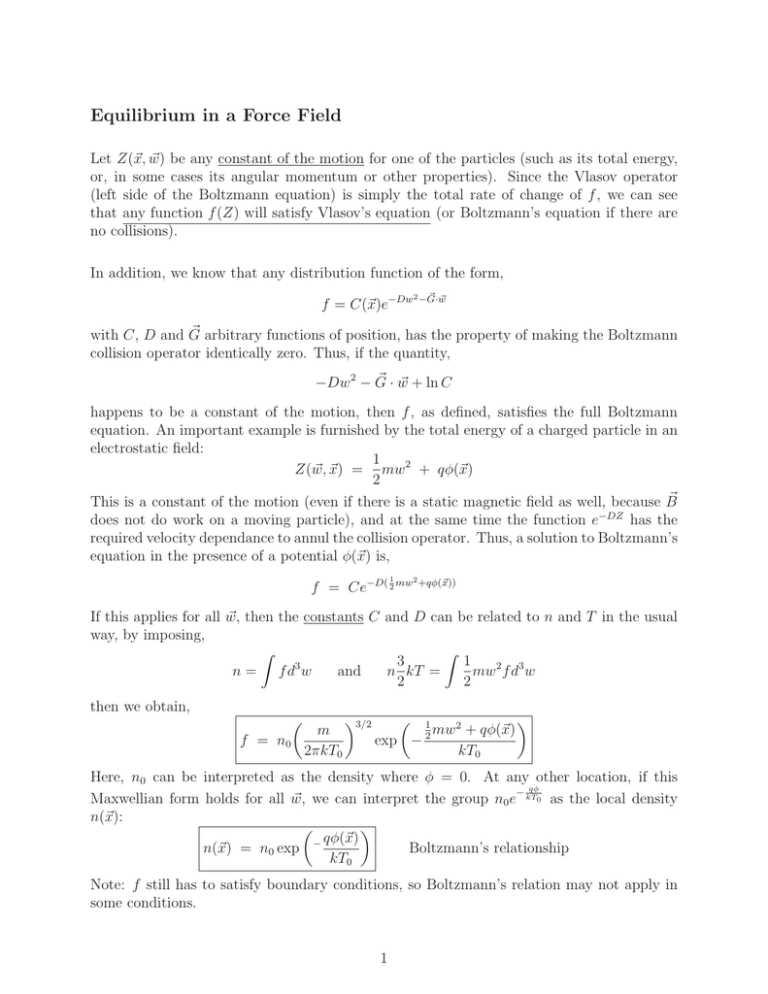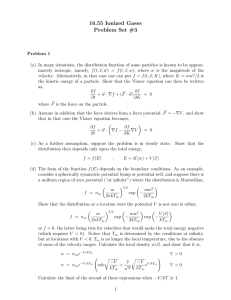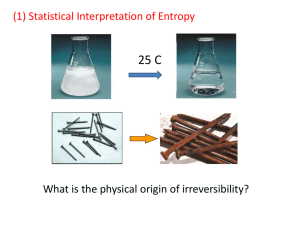Equilibrium
advertisement

Equilibrium in a Force Field Let Z(ix, w) i be any constant of the motion for one of the particles (such as its total energy, or, in some cases its angular momentum or other properties). Since the Vlasov operator (left side of the Boltzmann equation) is simply the total rate of change of f , we can see that any function f (Z) will satisfy Vlasov’s equation (or Boltzmann’s equation if there are no collisions). In addition, we know that any distribution function of the form, f = C(ix)e−Dw 2 −G· w w w i arbitrary functions of position, has the property of making the Boltzmann with C, D and G collision operator identically zero. Thus, if the quantity, i ·w −Dw2 − G i + ln C happens to be a constant of the motion, then f , as defined, satisfies the full Boltzmann equation. An important example is furnished by the total energy of a charged particle in an electrostatic field: 1 Z(w, i ix) = mw2 + qφ(ix) 2 i This is a constant of the motion (even if there is a static magnetic field as well, because B −DZ does not do work on a moving particle), and at the same time the function e has the required velocity dependance to annul the collision operator. Thus, a solution to Boltzmann’s equation in the presence of a potential φ(ix) is, 1 f = Ce−D( 2 mw 2 +qφ(w x)) If this applies for all w i , then the constants C and D can be related to n and T in the usual way, by imposing, � � 1 3 3 n = fd w and n kT = mw2 f d3 w 2 2 then we obtain, f = n0 m 2πkT0 3/2 1 exp − 2 mw2 + qφ(ix) kT0 Here, n0 can be interpreted as the density where φ = 0. At any other location, if this − qφ Maxwellian form holds for all w i , we can interpret the group n0 e kT0 as the local density n(ix): qφ(x) i Boltzmann’s relationship n(ix) = n0 exp − kT0 Note: f still has to satisfy boundary conditions, so Boltzmann’s relation may not apply in some conditions. 1 T0 is the temperature where φ = 0. It would also be the local T if the solution is full. Whether or not this solution applies in a specific case still depends on satisfying appropri­ ate Boundary Conditions. In some cases it is found that these conditions are different for different w i , and discontinuities can arise in the form of the actual solution. Some examples will clarify this. Example 1: Distribution function near an attracting wall. (qφ < 0) φ=0 x q In the situation, we assume there is an equilibrated distribution for particles of charge q far from the wall, where the potential is φ∞ = 0. So, far form the wall, φ f (w, i x → ∞) = n∞ φ(x) m 2πkT∞ 3/2 mw2 e− 2kT∞ The 12 mw2 in the exponent is the full energy E of the particle, but at locations near the wall, the same particle has the same E, only it now satisfies, φ = −ΔV V E = 1 mw2 + qφ(x) 2 We can then say that for particles that come from (+∞), the distribution is, f (w, i x) = n∞ m 2πkT∞ 3/2 1 mw2 + qφ(x) 2 exp − kT∞ (φ ≤ 0) But particles arriving from (−∞) have velocities limited by, wx ≥ 2q|φ(x)| m for any wy , wz and this is the only range for which the above distribution applies. If the wall absorbs all the arriving particles and returns none, then, f (wx < 0) = 0 and even stronger, f wx < 2q|φ(x)| m = 0 which is the limit corresponding to particles that start from (−∞) with nearly zero velocity towards the wall. We can now sketch this solution, at least its wx dependence (notice that the wy , wz depen­ dencies are the usual, complete Maxwellian, from −∞ to +∞): 2 Since a sizable part of the distribution is not Maxwellian, ( ) the relationship n(x) = qφ n0 exp − kT∞ does not apply in this case. Nevertheless, a direct integration can be performed. f (wx ) 0 There is an objection to this solution, however: as x → −∞, this tends to wx a half-Maxwellian (wx > 0) and not to the assumed full equilibrium. Col­ lisions and the finite dimensions of our “wall” (3D effects) need to be invoked to re-fill the wx < 0 part of the distri­ bution. 2q|φ| m Example 2: Distribution function near a repelling wall Once again, a candidate distribution is: φ f (w, i x) = n∞ φ = ΔV 3/2 1 mw2 + qφ(x) 2 exp − kT∞ This time any positive wx is allowed. Even particles with wx (−∞) > 0 can be stopped by the retarding poten­ tial. q φ(x) x m 2πkT∞ φ=0 However, for wx < 0 the fastest particles present would be the ones that were turned back very near the wall: 2q(ΔV − φ(x)) |wx | < (wx < 0) m Notice that when ΔV » kT the exq cluded region corresponds to highly supra-thermal particles, which have low population, and the full range could be assumed with negligible error. In parqφ(x) ticular, then n(x) ≈ n∞ e− kT∞ to a good approximation. f (wx ) − 2q[ΔV − φ(x)] m The generalization of these results is worth stating: The Boltzmann relation qφ(x) wx n = n∞ e− kT∞ is reliable when the par­ ticles are generally contained by the potentials, so that the net fluxes are small. It is not accurate when the po­ tentials tend to extract particles and 0 create strong fluxes. 3 MIT OpenCourseWare http://ocw.mit.edu 16.55 Ionized Gases Fall 2014 For information about citing these materials or our Terms of Use, visit: http://ocw.mit.edu/terms.






